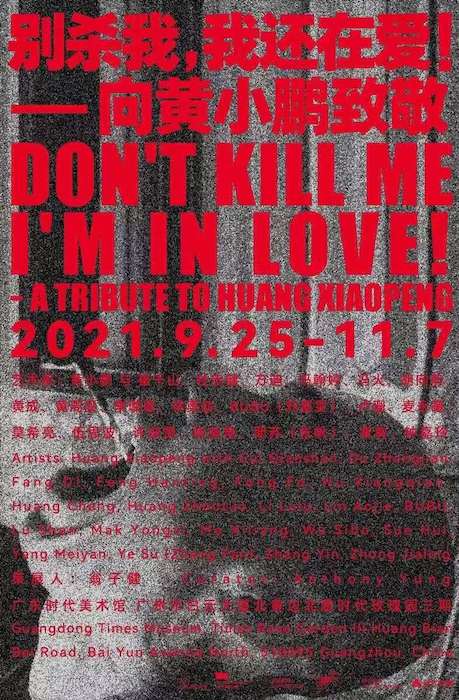
Don’t Kill Me I’m in Love!
- A Tribute to Huang Xiaopeng
Time 2021.9.25-11.7, 10:00-18:00 Tue. to Sun.
Guangdong Times Museum
Times Rose Garden III, Huangbianbei Road,
Baiyun Avenue. Exit C, Huangbian Station, Guangzhou Metro Line 2.
Admission Pay as you wish.
Curated by Anthony Yung
Participating Artists:
Huang Xiaopeng with Cui Qianshan, Du Zhongjian, Fang Di, Feng Hanting, Fong Fo, Hu Xiangqian, Huang Cheng, Huang Zhoutuo, Li Lulu, Lin Aojie, BUBU, Liu Yin, Lu Shan, Mak Yongxi, Mo Xiliang, Wu Sibo, Sue Hui, Yang Meiyan, Ye Su (Zhang Fan), Zhang Yin, Zhong Jialing
Organized by Guangdong Times Museum
Supported by Huang Xiaopeng Art & Education Society
Huang Xiaopeng has been one of the most important Guangdong artists of the past two decades. He enrolled at the Guangzhou Academy of Fine Arts in 1979, a testament to his academic excellence. Meanwhile, he was reportedly considered the academy’s top “bad boy”, because he smoked, drank, had long hair, and listened to rock music. As early as he was a student, he has managed to go beyond the old boundaries of Soviet academic style. His paintings were not appreciated by his teachers, but were admired by his peers. After graduation, his styles and his artistic ideas did not stop to progress. He belonged to the New Wave generation of Chinese art, and was involved in the Southern Artists Salon, a major art group in Guangzhou, from 1986 to 1987.
Xiaopeng was accepted into the Slade School of Fine Art in London in 1990 to pursue his master’s degree. The Slade’s emphasis on experimentalism formed a sharp contrast with Chinese fine arts academies. During his twelve years in the United Kingdom, Xiaopeng’s works had undergone a far-reaching expansion: Deciding early on to abandon oil painting, something with which he was familiar and in which he excelled, he started using a wide range of mixed materials to explore the possibilities of using everyday objects for symbolic expression.
In 2003, Xiaopeng returned to Guangzhou and began to teach at his alma mater, the Guangzhou Academy of Fine Arts. From 2004 through 2012, he was in charge of a course of contemporary art and became the leading teacher of “The Fifth Studio”. Filled with enthusiasm and idealism, he was a pioneer in teaching contemporary art at fine arts academies in China, profoundly influencing several generations of young artists in Guangzhou. After leaving the Guangzhou Academy of Fine Arts in 2012, he founded, together with Xu Tan, “HuangBian Station”, a platform to foster discussion and exchange among artists. In 2012, he also started teaching at the College of Fine Arts of South China Normal University.
In late 2018, Xiaopeng started planning to move to Berlin. In a diary entry for 18 April, 2019, he noted his aspirations for a future in Berlin and jotted down these passionate words:
DON’T KILL ME I’M IN LOVE!
However, in the least expected way, on 6 October, 2020, Xiaopeng died of a heart attack in Berlin at the age of 60.
It was not until 2005, when he was 45, that Xiaopeng began working with video. Instead of shooting his own footage, he was more interested in collecting, selecting, collaging, transforming and processing found materials in different media such as video, image, sound and text. These materials include news articles, historical sources, online resources, films and popular music. Often consisting of simple techniques and tools, his video works expressed sophisticated views. These works are the records of the artist’s intellectual exploration through sensory materials.
Xiaopeng’s later works can roughly be divided into two directions. The first direction involves his observations of and critical thinking about Chinese realities. After his return to China in 2003, he experienced a different kind of “culture shock.” China was full of bizarre things in his eyes. Only those who are both in the know and capable of taking a step back can fully “appreciate” the incongruous and the kitsch in today’s China and grasp their internal logic. This is why “mistranslation” was Xiaopeng’s favourite artistic means. In his “mistranslation,” translation did not aim to convey original meaning. It was a formal borrowing, an automatic association, a romantic estrangement, or to borrow Roman Jakobson’s description of literature, an “organised violence committed on ordinary speech.” It is probable that only those who have lived in societies with two or more languages, and have truly experienced the differences and conflicts between two or more cultures, are able to understand the nuances that lie within mistranslations and realise, on the most abstract level, that mistakes are also part of the truth.
The second direction consists of Xiaopeng’s more personal works. However, while also derived from reality, these works gradually move away from reality and take on obscure and poetic forms. These refer to his essay films, represented by K.O.H.D(2014-2016). In these works, he still used found materials, which he processed in a more stylised manner, making the original information and meaning of the materials more ambiguous and less relevant. In the end, what remained was a great number of sensory residues. These works are the artist’s inner wanderings.
In Xiaopeng’s last works, there is a convergence of these two trends. His critique of reality was internalised into a fundamental intellectual exploration, with observations intertwining with memories and going beyond expression. In reality, he never really settled down. However, he was probably already very close to his destination in his artistic mind. It was at this premature moment, before his art and thoughts are fully appreciated and recorded, that he left this world.
The current exhibition is the first ever systematic presentation of the key works by Xiaopeng from different phases. Together with the research work and his archives, it attempts to sketch an outline of Xiaopeng’s artistic career. The exhibition is also a result of the joint effort by his students. Some students are making new works to interpret and respond to Xiaopeng’s practice, his situational awareness, and the values that he upheld. Some others contribute to the various aspects of realising the exhibition, from design to production to writing.
After all, as his students, colleagues, and supporters, only by continuously working, creating, and doing interesting things can we best pay tribute to Xiaopeng.
Huang Xiaopeng (1960-2020) was an artist from Guangdong, China. Huang Xiaopeng’s works were featured in exhibitions worldwide, which include “Fear, No Fear” (Times Art Center, Berlin, Germany, 2021), “Chinafrika. under construction” (Galerie fur Zeitgenossische Kunst Leipzig, Germany, 2017), “The Man Who Never Threw Anything Away” (Times Museum, Guangzhou, China, 2017), “Pulse of the Pearl River Delta” (BFI, London, UK, 2016), “A Hundred Years of Shame – Songs of Resistance and Scenarios for Chinese Nations” (Para Site, Hong Kong, 2015), “The Poplar Tree and Mirror” (ISCP, New York, U.S., 2014), “Giorgio Andreotta Calo, Jalal Toufic, Huang Xiaopeng” (Whitechapel Gallery, London, UK, 2011), “Farewell to Postcolonialism: The Third Guangzhou Triennial” (Guangdong Museum of Art, Guangzhou, China, 2008). “The Thirteen: Chinese Video Now” (P.S.1 MOMA, New York, U.S., 2006), to name a few.
Anthony Yung is senior researcher at Asia Art Archive, specializing in the history of contemporary art in the Chinese regions. Yung is also a writer and a curator. He is the awardee of “The Fourth Yishu Awards for Critical Writing on Contemporary Chinese Art” (2014) and co-founder of Observation Society, an independent art space in Guangzhou.
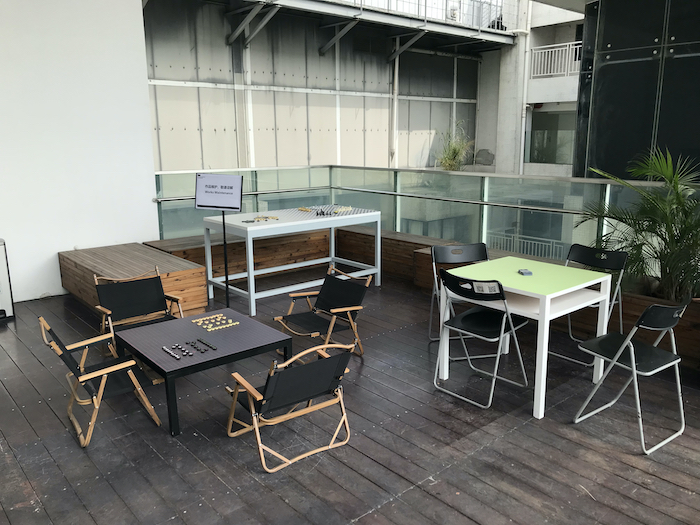
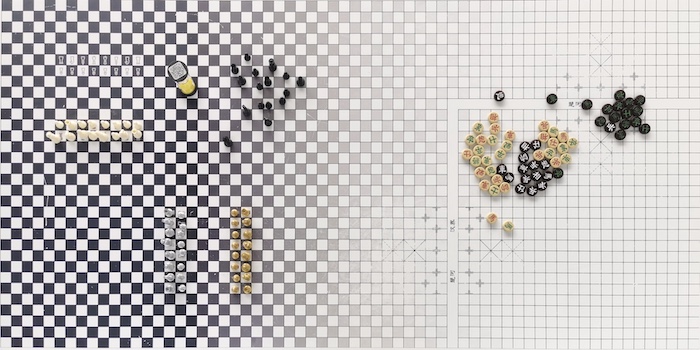
X 棋牌室
互动装置, 尺寸可变
X Game Parlour
interactive installation, dimension variable
2021
别杀我,我还在爱!
——向黄小鹏致敬
2021年9月25日-11月7日,周二到周日 10:00-18:00
广东时代美术馆
广州市白云大道黄边北路时代玫瑰园三期,广州地铁2号线黄边站C出口
门票: 无需预约,票价随你喜欢
策展人: 翁子健
参展艺术家:
黄小鹏 与 崔千山、杜忠健、方迪、冯翰婷、冯火、胡向前、黄成、黄周妥、李璐璐、林奥劼、BUBU(刘嘉雯)、卢珊、麦永曦、莫希亮、伍思波、许淑贤、杨美艳、耶苏(张帆)、章寅、钟嘉玲
黄小鹏是近二十年来最重要的广东艺术家之一。他在1979年考入广州美术学院,属优等生。但据说,由于吸烟喝酒留长头发及听摇滚等原因,他又被认为是该校当期数一数二的“烂仔”。在当学生期间,他的画作便已经超越了苏派学院的条框,虽不受老师的欢迎,却深得同辈同学的佩服。在毕业后,他的风格及艺术观仍然不停演进。他属于新潮美术的一代,曾参与1986-1987年间广州重要的艺术小组“南方艺术家沙龙”。1990年,小鹏考入伦敦的斯莱德美术学院,攻读硕士课程。斯莱德美院的教学重视实验性,与中国的美术教学完全不同。旅居英国的12年间,小鹏的创作经历了深远的拓展:他不再使用熟悉而擅长的油画,改为混合使用各种材料,探索利用日常物件进行象征性表达的可能性。
2003年,小鹏回到广州,任教于母校广州美术学院。2004至2012年,他在美院担任“第五工作室”的主任老师,并主持一门当代艺术选修课。他是一位热诚、尽责,及抱着理想主义的老师,他的教学实践是中国正规美术学院中进行当代艺术教学的先驱榜样,并影响了两至三个世代的广州年轻艺术家。2012年离开广州美术学院后,他与徐坦一起创办了艺术家讨论和交流平台“黄边站”。2012年起,他在华南师范大学艺术学院任教。
在2018年底,小鹏打算移居柏林。在2019年4月18日的日记中,他表达了对未来在柏林生活的向往,及写下了这句满怀热情的话:
DON’T KILL ME I’M IN LOVE !
让所有人都始料不及的是,在2020年10月6日,小鹏因突发心脏病在柏林去世,终年60岁。
小鹏2005年开始使用录像创作,当时他已45岁。相比拍摄,他更感兴趣对不同媒介如影像、图像、声音、文字等的现成材料的收集、选择、拼贴、改装及加工。这些材料包括新闻、历史资料、网上资源、电影及流行音乐。他的录像作品往往只用简单的制作技术及条件,便足以造就种种复杂表达。这些作品是他以感官材料进行思辨的纪录。
小鹏的后期作品可大致分成两类。第一类,涉及他对中国现实的观察和批判性思考。在2003年回到中国居住后,他体验到一种别样的“文化冲击”,中国在他眼里充满了光怪陆离的事。只有既熟悉又带着距离观察,才能充分“欣赏”当代中国的怪诞和刻奇,并掌握其内在逻辑。因此,“误译”是小鹏最喜欢的艺术手段。在他的“误译”中,翻译不旨在传达事物之本来意义,而是一种形式上的借用、自动联想和浪漫的陌生化,甚至,借用罗曼·雅格布森(Roman Jakobson)对文学的描述,是一种“对日常话语的有组织性地施暴”。大概只有那些曾生活在两种语言的社会中,深刻地体会过两种文化之间的差异和冲突的人,才能理解当中的趣味,并在最抽象处领悟到错误原是真相中的一环。
第二类,是一些更个人化的作品。这些作品同样从现实出发,却逐渐远离现实,走向晦涩和诗意。这类作品中最具代表性的是他创作于2014年及2016年的两部论文电影《K.O.H.D.(敲叩天堂之门)》。在这些作品中,他将现成素材处理得更加风格化,使其本来面貌变得更加含糊,更加不重要,剩下的只是一堆感官剩余物。这类作品,就是艺术家内心的漫游。
在小鹏最后的作品中,出现了上述两个方向的合流。对现实的批判,内化成一种根本性的思辩;观察和回忆交织在一起,变得更加难以言喻。在现实中,他从未安定下来。但是,在他艺术内心中,大概已非常接近目的地了。却在此节点,在他的艺术和思想获得充分的重视和记载之前,他就过早地离开了这个世界。
本次展览将首次将系统性地展出小鹏生涯各阶段的重要作品,配合对文献的梳理及研究,试图勾勒出一个具代表性的轮廓。这个展览也是小鹏的学生们共同努力的成果。他们有些以专门创作的新作,表达对小鹏的作品、境遇,及他所秉持的价值之回应及诠释;另一些人则参与到展览的设计、制作和文书等各项工作。
对小鹏的学生、志同道合者和支持者来说,只有持续不断地工作、创造、做有意思的事,才是向他最好的致敬。
黄小鹏(1960-2020)是一位来自中国广东的艺术家。黄小鹏的作品曾在世界范围内展出,曾参与展览包括:“畏无所畏”(时代艺术中心,柏林,2021年)、“中非:建设中”(莱比锡当代美术馆,莱比锡,2017年)、“时代异托邦三部曲之III ——从不扔东西的人”(时代美术馆,广州,2017年)、“影像珠三角”(英国电影学会BFI,伦敦,2016年)、“土尾世界——抵抗之转喻和中华国家想象”(Para Site,香港,2015年)、“杨树和镜子”(ISCP,纽约,2014年)、“乔治·安德里欧塔,卡洛·贾拉·图菲克,黄小鹏”(白教堂美术馆,伦敦,2014年)、“与后殖民说再见——第三届广州三年展”(广东美术馆,广州,2008年)、“13个:今日中国影像”(MOMA P.S.1,纽约,2006年)等等。
翁子健 是亚洲艺术文献库的资深研究员,其研究针对华语地区现当代艺术的历史。此外,他也从事评论及策展工作。他是第四届《Yishu》当代中国艺术评论写作奖(2014年)的得主,也是位于广州的独立艺术空间观察社的创办人之一。
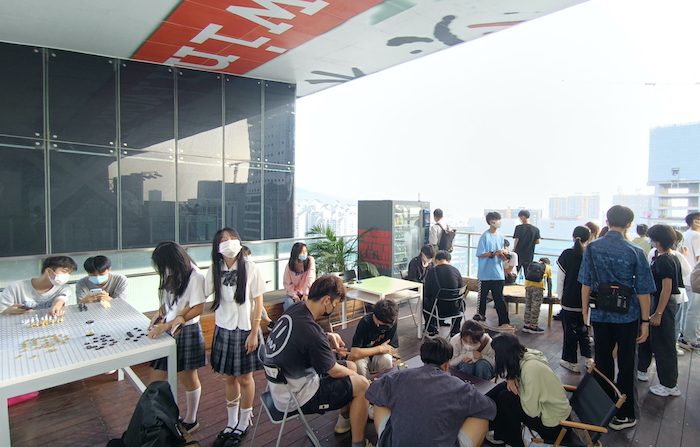
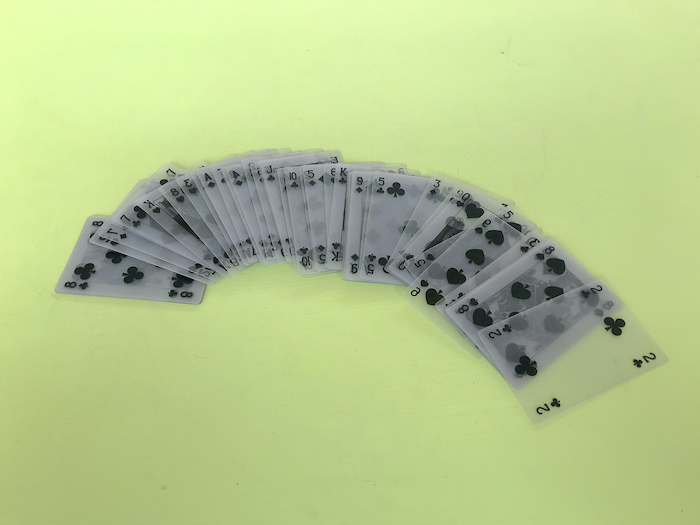
X 棋牌室
互动装置, 尺寸可变
X Game Parlour
interactive installation, dimension variable
2021
Copyright © 张帆 ZhangFan
